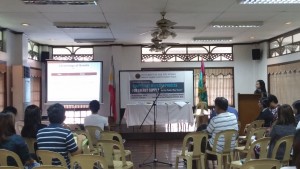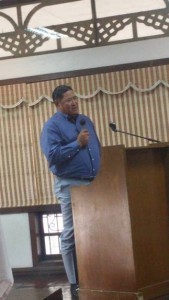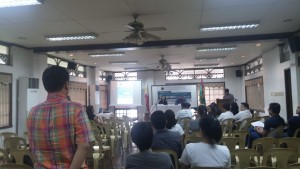UP Sustainable Energy Program Midyear Meeting

By Gen Rodriguez
The UP SEP Mid-year meeting was held for the whole day on September 28, 2016 at the GT-Toyota Asian Center, University of the Philippines Diliman. It focused on the updates on the general activities, the current research projects, as well as a brainstorming session regarding the to-be published SEP policy journal.
The project updates included Standardization of Equipment for Sustainability by Prof. Juvy Balbarona and Prof. Ferdinand Manegdeg, Li-ion vs. Lead Acid: Life Cycle and Cost Analysis in the Philippine Context by Prof. Jhud Aberilla and Market and Technology Assessment of Electrical Energy Storage for Renewable Energy in the Philippines presented by Prof. Joey Ocon and Prof. Rinlee Butch Cervera. Below is a summary of the proceedings classified per project.
Standardization of Equipment for Sustainability
This project started on May 2016 in conjunction with the release of the budget and they are hoping to end in May 2017. Its objective is to develop compliance standards for Philippines demand, which will be a basis for the procurement policy of the university. It will help them provide technical specification of the fixture, for example air conditioning units, lightings, and other commonly procured equipment. The study will not include highly specialized laboratories and equipment from such. The study will also serve as an input for policy making in equipment disposal.
For the study, an energy audit of the different facilities would determine the type of equipment needed and its corresponding classification. Initially, the total number of buildings to be audited was 42 and to have a statistically significant number, 80% of the total buildings in the university must be audited. This count is based on the meters connected to the system. However this number has gone down to 37 since some of the meters have pure street lights loads and some meters have less than 10 years of cumulative data. There were also problems encountered in energy audit building permits which would lessen the count to 33 buildings.
For the remainder of the project’s timeline, the team hopes to include workshops for the introduction of the equipment standards to stakeholders such as the students, faculty, and the administration. They would also like to have a meeting with key decision makers such as TWG, SPMO, the secretariat, Bids and Works Committee, OVCA, and the chancellor to introduce their findings and to give recommendations on the standards of the procured equipment in line with energy efficiency standards. They also want to have a workshop with the suppliers to determine the capability, technology specifications and market prices of commonly procured equipment.
Li-ion vs Lead Acid: Life Cycle and Cost Analysis in the Philippine Context
This project is led by Sir Jhud Mikhail Aberilla and Sir Carlo Tolentino, with the support and assistance of Dr. Viona of DLSU and Engr. Bacolor from EVWealth. The objective of the study is to take on a life cycle approach on two types of batteries namely the lithium ion and the lead acid battery. Here in the Philippines, lead acid batteries are manufactured locally while lithium ion ones are imported from other countries. Currently, the project has information on manufacturing the lead acid battery while there are some challenges for the lithium ion production process. Battery materials are dependent on international relations in terms of lithium, cobalt, nickel, lead batteries.
The project has an inventory using Simacro that includes battery production. The electric vehicles use electricity instead of fuel, gasoline or diesel and there is no special grid for charging of the electric vehicles, thus the study wants to look at the effect of electric vehicles in the main grid, how the energy mix will change, and whether this will affect the sustainability of an electric vehicle. Aside from this, the research also wants to determine at least a baseline or low emissions development scenario for future energy scenarios. One of their final outputs is to develop heuristics for battery life cycle management.
Market and Technology Assessment of Electrical Energy Storage for Renewable Energy in the Philippines
The main objective of this study is to introduce more energy storage solutions into the Philippine energy system, particularly in island grids since most of the electricity requirements are supplied by diesel base mini grids and the implications are high generation cost and CO2 emissions.
Other objectives of the project are to study the future markets for EES in the Philippines especially in the context of providing more energy from renewable energy, to identify and map the various energy storage technology, to suggest the energy storage technology based on choice, suitability and needs of the resources, to look at the buyer’s implementation of energy storage in the project and to recommend policies for wider adoption and implementation of energy storage projects.
Currently, the project classified the electric energy storage into five: mechanical, electrochemical, chemical, thermal, and electrical. In the Philippines we have a pumped hydro system, lead acid batteries, and lithium ion batteries for large scale and lead acids as well as nickel metal hydrite, sulfur based facilities for secondary batteries.
For future activities on the project, the proponents were able to map renewable energy and battery energy storage. The researchers are currently doing a case study for household battery energy storage. Other future works include interview with the stakeholders in DOE, NEA and NGCP, transport sector, some private and nonprofit organizations. Hopefully the team may be able to finish the project on time by December 2016.















